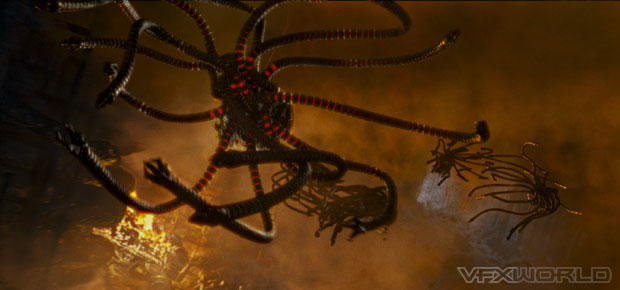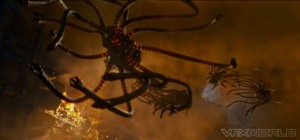
 Archival interview with Jonathan Dyer from the official Matrix website.
Archival interview with Jonathan Dyer from the official Matrix website.
MATRIX: What has your role been on THE MATRIX sequels?
JONATHAN: I’ve been working in a couple of different roles. I initially started as a CAD Draftsperson working with the Art Department and was involved with the Sentinel creature. I have since moved into the Digital Assets Department, and am involved with cataloging and databasing of all the data created for these films.
MATRIX: How did the Sentinel project begin?
JONATHAN: Essentially the Sentinel began with a redesign from the first film – in the first film you can see there are creatures attacking the ship towards the end and at different points during the movie. Owen [Paterson, Production Designer] had redesigned them with some of the guys in the US because there was a call for full 1:1 size props because of the scenes involved. In the sequels there have been a number of scenes calling for large scale props. Owen worked with a Concept Artist, and also with Grant Niesner who is the 3D Creature Designer.
MATRIX: Why did the Sentinel need to be redesigned from the first film?
JONATHAN: I think it was a case of them wanting to update it, and possibly make it more aggressive looking; the focus has been on increasing the intensity of its look.
MATRIX: As soon as Grant had done his 3D work, what was the next step for you?
JONATHAN: We started looking at the 1:1 size of the Sentinel, which became a bit of a process – we ended up changing the size quite a few times – and we started discussions with the Model Making Department based on how they thought they were going to be able to make the different components. That led to us using the 3D data that Grant created in Maya, importing that into a number of different packages, and translating it according to what we knew the Model making Department could do and the techniques they were going to use. So we turned that data into a set of working drawings from which they could build all of the parts. The drawings were done with a lot of detail in the contouring and how all of the shapes work because there is a strong focus on these creatures in the visual effects aspect of the film. The physical models had to be quite accurate in terms of representing what was going to be shown in the visual effects.
There were a lot of discussions about how the tentacles were going to actually work. At one stage they were going to light up – and then they weren’t – we were looking at having a lit core running through the center, and at having the individual sections within each link lighting up. You can see on some of the Sentinels around the sets that they’ve got special effects hoses running through the tentacles themselves, which will ultimately mean that there is gas or steam that coming out of there.
We also looked at having articulated claws, we looked at how the body was going to be molded, and at how many sections were going to be made. There was a process where the actual creature itself got sliced into about thirty or forty different sections that were all sent out for laser cutting profiles, and they basically formed a skeleton from foam that then got shaped by the Model making Department. They had the sectioned Sentinel body on a spit so they could sit there and rotate it, depending on which section they were working on at the time. They were working from 1:1 drawings that we’d printed out and plastered up on the wall.
We modified the legs slightly to simplify them for manufacture, and we looked at whether or not they needed to pivot and how we were going to attach them to the body, then how they would pivot once they were on the body. We also looked at little things like the feelers and just how functional they had to be. The eyes were important too: how were we going to do the eyes in order to get the red color – which is a very different finish to the actual body itself – so that became a different material. All kinds of manufacturing and fabrication techniques became involved.
MATRIX: At that point did you know how many Sentinels were going to be built?
JONATHAN: Initially there was a huge number and then that became six at one point, so we were looking at six. Then as everything evolved, as you can see on the different sets, the project took on a life of its own: people saw the Sentinel and it suddenly became an element they were going to use in the stage, so they ended up making a lot more of them. At that point we’d done the exterior, and then the Props guys came in and worked off some very loose sketches and 3D models to create the interior, which the Set Decorating people have done an amazing job of creating – the battle scarred effect.
MATRIX: The claws are not articulated, but some are open and some are closed; was that the compromise?
JONATHAN: Yes, that was really a cost based decision. It was a very simple process to make one in the open position: it’s actually the same element repeated itself around four times. We just made the one claw piece, cast it four times, repeated it around, and then cast the whole thing as one piece.
MATRIX: How long did you work on the Sentinel drawings?
JONATHAN: I think it was about four months altogether. I worked on it with Owen’s input and Jules [Cook, Art Director] oversaw the project.
MATRIX: What material are the eyes made from; will they glow?
JONATHAN: Initially we were going to have the eyes glowing and then flickering and then dying, but it became a very expensive process. We ended up casting them from a resin that we can get a very high polish on. The design to build the Sentinels from is very slightly different to the model that’s used in the Visual Effects Department, in that the eyes have been reduced to just three different sizes. This way we can just modify the way that these actually sit within the body to achieve a different look. We looked at the red color of the eyes to try and simulate the rear lights of a car, so that once the Sentinel had stopped functioning, the glow in the eyes died completely, and the red dies to a very dark red color.
MATRIX: Is the gill-like part of the Sentinel actually a gill?
JONATHAN: Yes, the idea is that these are gills and as it flies or moves through the sewers these open and shut, so it’s almost like their breathing apparatus and there’s a large air intake structure on the front. In a sense the Sentinels are slightly organic and they have some marine-like elements. The Sentinels were one of the most amazing things to see the Prop Manufacture guys create – watching them evolve over a few days.
MATRIX: How did Prop Manufacture use your drawings?
JONATHAN: They created a pattern from the drawings and that pattern got vacuum-formed. Then they created the external form, which is like an external shroud, and within that shroud they placed the vacuum-formed shape. Some of the most amazing things to see being sculpted were the legs themselves as they were just absolutely beautiful – the molds for those were done in wood.
MATRIX: What types of materials were the Sentinels made from?
JONATHAN: This one in particular would be mostly foam: the main body is cast foam that’s a thickness of about three to four centimeters, the tentacles themselves are foam, some of the tentacles are spongy and some are hard, and the legs are foam as well.
MATRIX: Thanks Jonathan.
Interview by REDPILL
July 2002

Be the first to comment